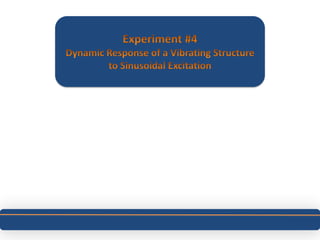
Dynamic Response Of A Vibrating Structure To Sinusoidal Excitation
- 1. Experiment #4 Dynamic Response of a Vibrating Structure to Sinusoidal Excitation
- 2. Objectives Perform a standard vibration test to measure the frequency response of a structural system 1. Solve a differential equation describing the motion of a structure with one degree of freedom under sinusoidal excitation 2. Calculate the equivalent viscous damping coefficient (ζ) of a single degree of freedom structure 3.
- 3. Test Specimen and Test Setup Exciter Load Cell Accelerometer Specimen
- 4. Part I – Frequency Response Forced Response Free Response Manual Excitation Mechanical Excitation
- 5. Forced Response Node First Mode – 10.1 Hz First Resonance – displays one node
- 6. Forced Response Second Mode – 68.8 Hz Nodes Second Resonance – displays two nodes
- 7. Forced Response Third Mode – 115 Hz Nodes Third Resonance – displays three nodes
- 8. Forced Response Before 68.6 Hz Resonance 𝑋𝐹0 is small Force Acceleration In phase
- 9. Forced Response Before 68.6 Hz Resonance 𝑋𝐹0 is small Force Acceleration In phase
- 10. Forced Response At 68.6 Hz Resonance 𝑋𝐹0 is large Force Acceleration 90° phase shift
- 11. Forced Response After 68.6 Hz Resonance 𝑋𝐹0 is small Force Acceleration Back in phase
- 12. Magnitude Ratio vs. Frequency Experimental data indicates that there is a resonance ~ 68 Hz
- 13. Phase Angle vs. Frequency Experimental data indicates that there is a phase shift of 90° at ~68 Hz
- 14. Free Response Acceleration Decreasing acceleration and decreasing displacement
- 15. Part II – Lumped Parameter Model The diagram below describes the motion of our beam: x F = applied force by the exciter X = beam displacement
- 16. Single DOF Spring-Mass-Damper System The mathematical model we used to describe the motion of the beam was a Single DOF Spring-Mass-Damper System. X(t) = displacement F(t) = applied load m = mass k = spring constant c = damping coefficient
- 17. Single DOF Spring-Mass-Damper System The lumped parameter model can be modeled by a non-homogeneous differential equation: 𝑚𝑥+𝑐𝑥+𝑘𝑥=𝐹(𝑡) We developed two particular solutions to this DE: 𝜙=tan−1−2𝜁𝜔𝜔𝑛1−𝜔𝜔𝑛2 - Phase angle between forcing function and the displacement of the beam 𝑋𝐹0=1𝑘1−𝜔𝜔𝑛22+2𝜁𝜔𝜔𝑛2 - Magnitude ratio of displacement and applied force
- 18. Part III – Equivalent Viscous Damping Coefficient (ζ) Three Methods for Finding ζ Half-Power Method Log Decrement Method Best Guess Method
- 19. Half-Power Method 𝜁𝐻𝑃=𝑓2−𝑓12𝑓𝑛 The half-power method utilizes frequencies on either side of the natural frequency along with the natural frequency to approximate the viscous damping coefficient (ζ). 𝜁𝐻𝑃=69.1142−68.52952∗68.9 𝜻𝑯𝑷=𝟎.𝟎𝟎𝟒𝟐𝟒𝟗
- 21. Log Decrement Method The log decrement method utilizes frequencies at different points along the Free Response result in Part I. 𝛿=1𝑛ln𝑥0𝑥𝑛 - This is the log decrement The log decrement is then used to find the viscous damping coefficient (ζ): 𝜁𝐿𝐷=11+2𝜋𝛿2 𝜁𝐿𝐷=11+2𝜋0.075972 𝜻𝑳𝑫=𝟎.𝟎𝟏𝟐𝟎𝟗
- 22. Best Guess Method The Best Guess Method involved simply picking a value for ζ and then plotting the theoretical curves alongside the experimental data. The correct value of ζ is found when the theoretical curves match the experimental data. 𝜻𝑩𝑮=𝟎.𝟎𝟏
- 23. Comparison of HP and LD ζ Values Differential error analysis shows that: 𝜎𝜻𝑯𝑷 =7∗𝜎𝜻𝑳𝑫 Therefore, we conclude that the Log Decrement Method is a much more accurate method of calculating the viscous damping coefficient (ζ).
- 24. Frequency Response Function Curves - Magnitude Magnitude Ratio vs. Frequency, ω All curves agree as to the location of the resonant frequency The value of ζ affects both the height of the curve and the slope leading up to the resonance 68.6
- 25. Frequency Response Function Curves – Phase Angle (φ) Phase Shift, φ vs. Frequency, ω All curves indicate that there is a phase shift of ~90° at 68.6 Hz FRF curves don’t correlate well with the experimental phase shift in this region 68.6
- 27. The magnitude ratio curves produced by our model correlate very well with our experimental data.
Notes de l'éditeur
- Second derivative of sin is –sin